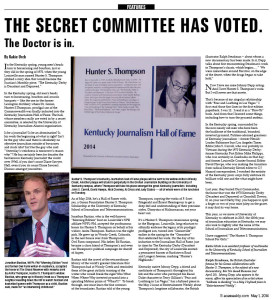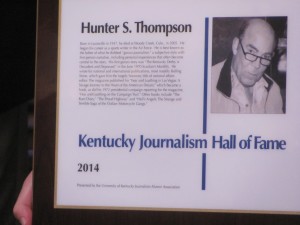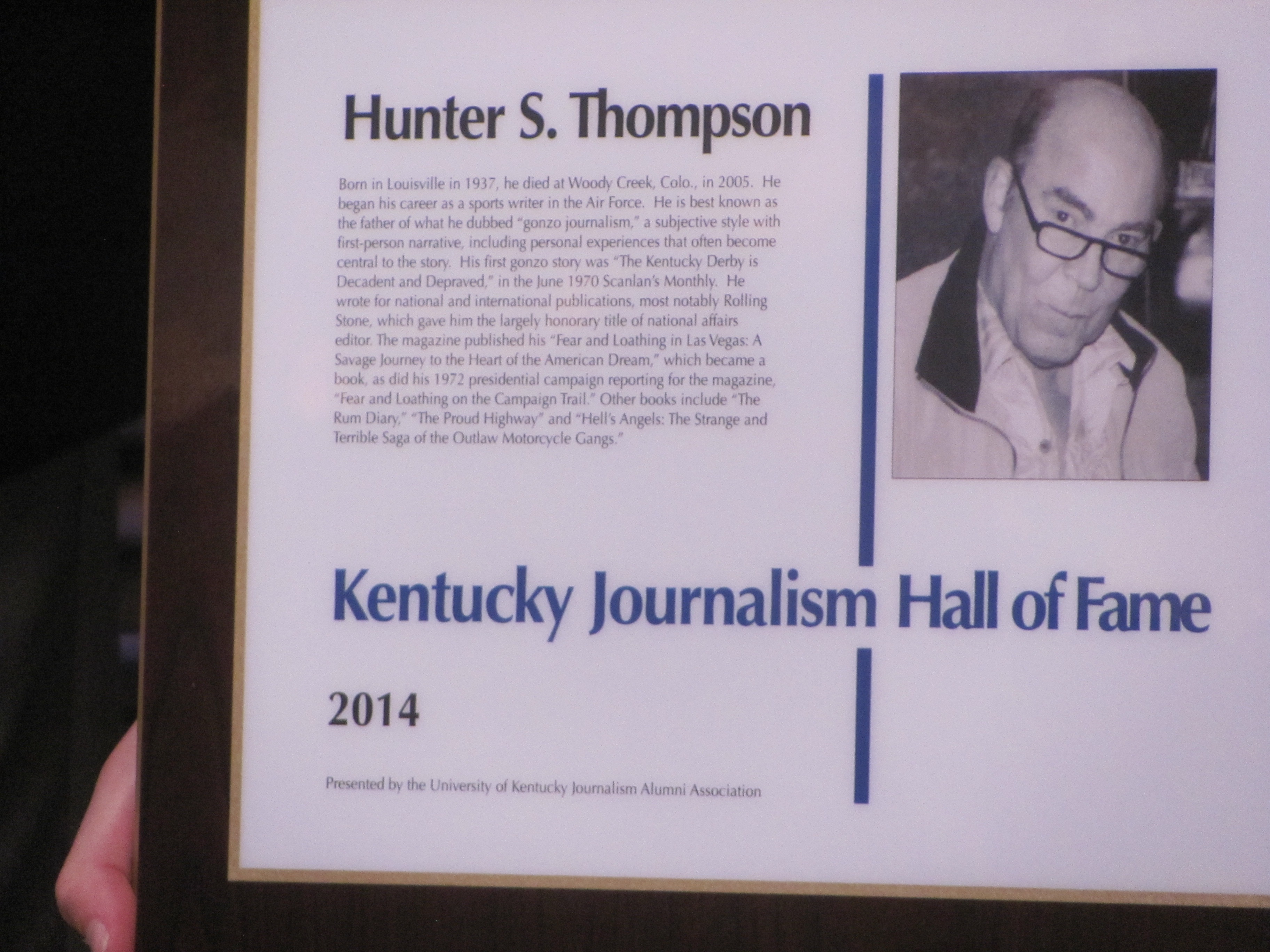By Kakie Urch
In the Kentucky spring, young men’s heads turn to horseracing and bourbon, just as they did in the spring of 1970, when the young Louisville man named Hunter S. Thompson pitched a story idea that would become the Scanlon’s Monthly piece, “The Kentucky Derby is Decadent and Depraved.”


Is he a journalist? Is he an abomination? Is his work the beginning of what is right? Isn’t he the guy who said there is absolutely no objective journalism outside of boxscores and stock tabs? Isn’t he the guy who said “Today’s weirdness is tomorrow’s reason why”? He has certainly been for decades the best-known Kentucky journalist the world over (Well, if you don’t count Diane Sawyer. Hell, even if you do count Diane Sawyer). Discuss amongst yourselves.
As of May 2014, he’s a Hall of Famer with, yes, a Gonzo Foundation Hunter S. Thompson Scholarship at the University of Kentucky School of Journalism and Telecommunications.
Jonathan Bastian, who is the well-known “Morning Edition” host on Louisville’s NPR affiliate WFPL-FM, accepted the posthumous honor for Hunter S. Thompson on behalf of his widow, Anita Thompson. Bastian was the right pick. He grew up in Woody Creek, Colorado, in the next house over from Thompson’s Owl Farm compound. His father, Ed Bastian, became a close friend of Thompson’s and even ran Thompson’s political campaign for sheriff of Aspen.
Bastian told the crowd of the extraordinary library of the world’s greatest literature that Thompson had at Woody Creek and reminded them of the great stylistic training of the writer who would break the rigid Who What When Where Why inverted pyramid into a spiraling Mobius prism of “Whaa?!!!” To break through, one must learn the fine contours of the boundaries. Bastian told of the young Thompson, copying the works of F. Scott Fitzgerald and Ernest Hemingway to get a deep feel and understanding of their precision styles. Dionysius of Halicarnassas, eat your heart out.


Kentucky native Johnny Depp, a friend and confidante of Thompson’s throughout his life and the actor who portrayed his Raoul Duke character in Terry Gilliam’s “Fear and Loathing in Las Vegas,” has a bylined piece in the May 2 issue of Entertainment Weekly about Thompson’s longtime collaborator, the British illustrator Ralph Steadman — about whom a new documentary has been made. In it, Depp talks about first encountering Steadman’s work in Thompson’s classic, which begins…. “ ‘We were somewhere around Barstow, on the edge of the desert, when the drugs began to take hold.”
Now I love me some Johnny Depp acting. And I love Hunter S. Thompson’s work. But I will never see that movie.
That’s because of my singular relationship with “Fear and Loathing in Las Vegas.” I first read those first lines in the first edition paperback. I was 12. I read it as a “How-To” book. And from that I learned some things, including how to turn the pyramid mobius.
In the Kentucky spring, surrounded by the now-nearly old men who have been the backbone of the traditional, bounded, inverted pyramid, Pulitzer-adorned greatness of Kentucky journalism — former Herald-Leader/Baltimore Sun/Los Angeles Times Editor John S. Carroll, who was probably in Vietnam during the 1970 Kentucky Derby; former Kentucky Post Editor Mike Philipps, who was certainly in Cambodia on that day; and former Louisville Courier-Journal Editor David Hawpe, who was making the transition from radical Kentucky Kernel editor to C-J Hazard correspondent, I watched the entirity of the Kentucky press corps fully embrace its brilliant wild one and the what might have been.
Last year, they buried Dust Commander, the horse that won the 1970 Kentucky Derby (Decadent and Depraved) at Churchill Downs. If, on your next Derby Day, you happen to spill a finger or two of your mint julep on the grave, it may find its way home.
This year, as we move at University of Kentucky to celebrate in 2015, the 100th year of journalism education in Kentucky, we may also look to slightly alter the name of the School of Journalism and Telecommunications.
I have suggested “The Hunter S. Thompson School For Girls.”
Kakie Urch is an assistant professor of multimedia in the University of Kentucky School of Journalism and Telecommunications.
Ralph Steadman, the British illustrator famous for his Gonzo collaborations with Hunter S. Thompson, is the subject of a new documentary, For No Good Reason (out April 25). Johnny Depp, who appears in the movie, offers his appreciation of an artist whose “boldness is shocking” in a May 2 bylined piece in “Entertainment Weekly”.










